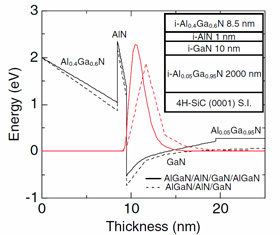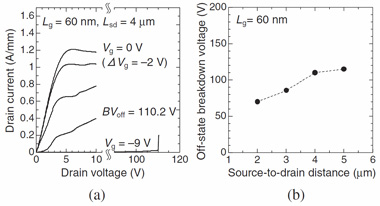
| Home | About Us | Contribute | Bookstore | Advertising | Subscribe for Free NOW! |
| News Archive | Features | Events | Recruitment | Directory |
| FREE subscription |
| Subscribe for free to receive each issue of Semiconductor Today magazine and weekly news brief. |
News
7 October 2009
Boosting frequency-breakdown trade-off for AlGaN HFETs
Researchers from Japan’s National Institute of Information and Communications Technology (NICT) and Fujitsu Laboratories Ltd have developed extreme high-frequency (118GHz) heterostructure field-effect transistors (HFETs) with an aluminum gallium nitride (AlGaN) back-barrier to maintain an off-state breakdown voltage of more than 110V [Norio Onojima, Japanese Journal of Applied Physics, vol.48, p094502, 2009].
Gallium nitride (GaN) has recently been looked at as a key material for producing the next generation of high-power components such as power amplifiers for radio transmission up to about 30GHz, with a leading potential application being for mobile network base-stations. This is based on high saturation velocities for electrons and high breakdown fields based on the wide bandgap of III-nitride materials (about 3x and more, compared with silicon).
Last year, a 60nm gate AlGaN/GaN-based HFET achieved a current-gain cutoff frequency (fT) of 190GHz [Higashiwaki et al, Appl. Phys. Express, vol.1, p.021103, 2008]. This sort of result makes III-nitrides of interest to applications beyond mobile phone, wireless networking, etc., and into the millimeter wave (MMW) range of frequencies (30-300GHz, 10-1mm) with applications such as point-to-point, inter-satellite and point-to-multipoint communications, as well as high-resolution radar. However, to meet the requirements of these applications, a high breakdown voltage in the off-state is needed to give an adequate maximum output power.
The team grew its structure on a 4H-SiC substrate (Figure 1) using metal-organic chemical vapor deposition (MOCVD). The HFET includes a double-barrier arrangement (AlGaN/GaN/AlGaN) with top and back/buffer barriers constructed of AlGaN with different compositions (top 40% Al, back 5% Al). Simulations using a one-dimensional Poisson-Schrödinger solver with and without the back-barrier suggest that the two-dimensional electron gas is more efficiently confined with the back-barrier arrangement. This is attributed to the combined effects of the conduction-band offset and the presence of a polarization-induced sheet charge.
 Figure 1: Conduction band diagram and calculated electron concentration distributions with and without back-barrier. Schematic of device structure inset.
Figure 1: Conduction band diagram and calculated electron concentration distributions with and without back-barrier. Schematic of device structure inset.
The T-shaped gate electrode measured 50x2μm with a 60nm gate length. The separation between the source and drain electrodes was varied from 2 to 5μm. The fT was highest with the 2μm distance (132GHz) and fell to 118GHz for the 5μm separation. The researchers attribute this to an increase in the access resistance. The paper comments that the change in cut-off is relatively small due to the low sheet resistance of 228Ω/sq.
The breakdown voltage varied in the opposite direction, being highest at 5μm source-drain separation (Figure 2). Both the 4μm and 5μm devices had breakdowns higher than 110V. The three-terminal breakdown voltage was defined as the drain voltage at which the increase in drain current density (Id) was 5x102A/mm when the drain current–drain voltage characteristics were measured at a gate bias below the threshold voltage (Vth).

Figure 2: Drain current-voltage characteristics for 4μm source-drain distance (a) and variation of breakdown with source-drain distance (b).
Some electroluminescence was observed during the breakdown measurements, possibly due to high-energy carrier generation under the high bias conditions. It is hoped that further study of this effect could lead to improvements in breakdown characteristics.
The researchers comment that comparison experiments with devices not having the back barrier are needed to confirm the role of the back-barrier in improving breakdown performance. ![]() Search: AlGaN HFETs GaN 4H-SiC substrate MOCVD
Search: AlGaN HFETs GaN 4H-SiC substrate MOCVD
Visit: http://jjap.ipap.jp/link?JJAP/48/094502/
The author Mike Cooke is a freelance technology journalist who has worked in the semiconductor and advanced technology sectors since 1997.